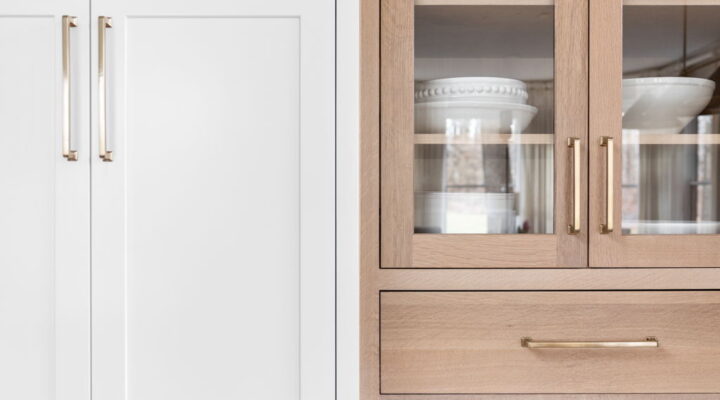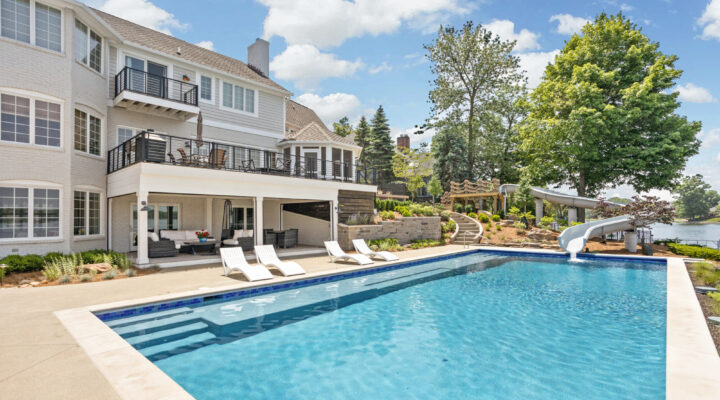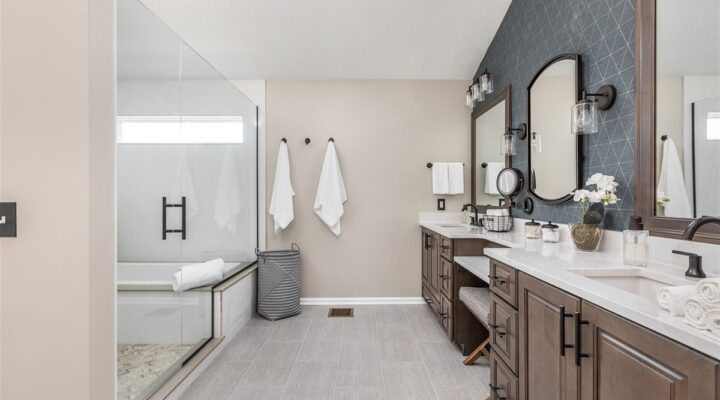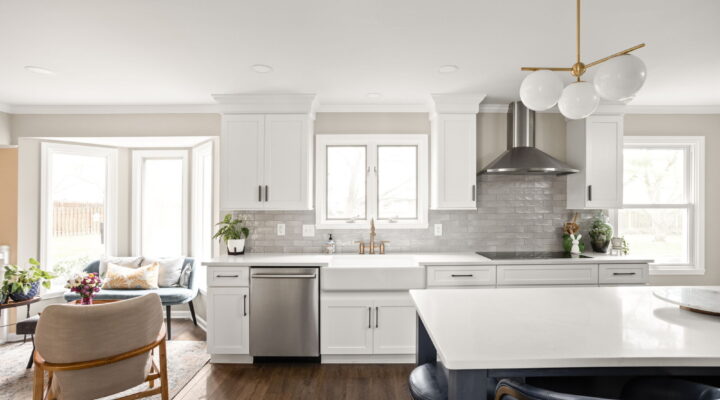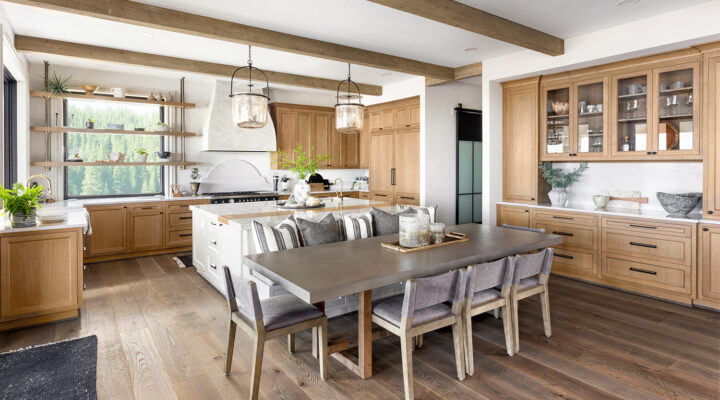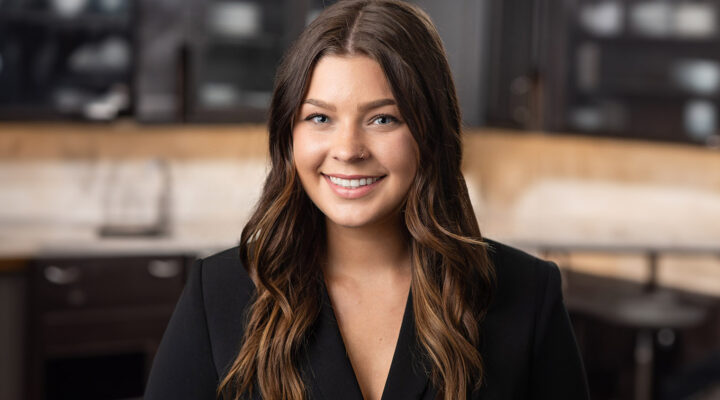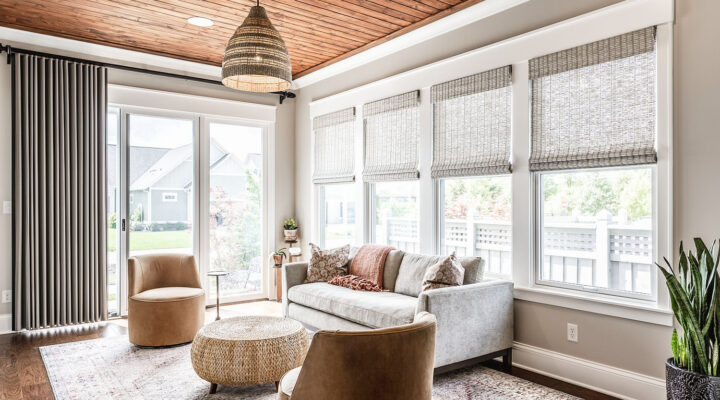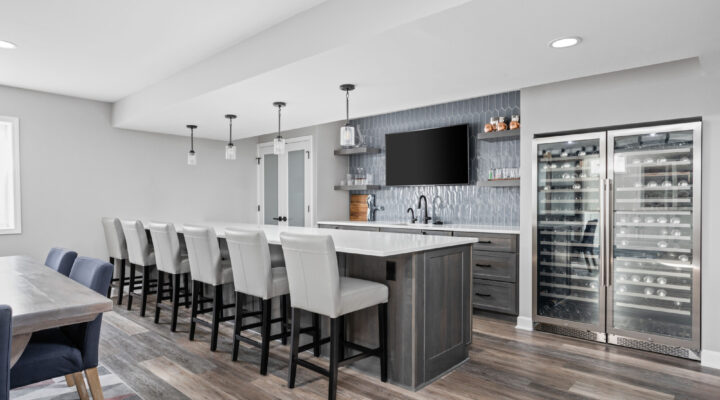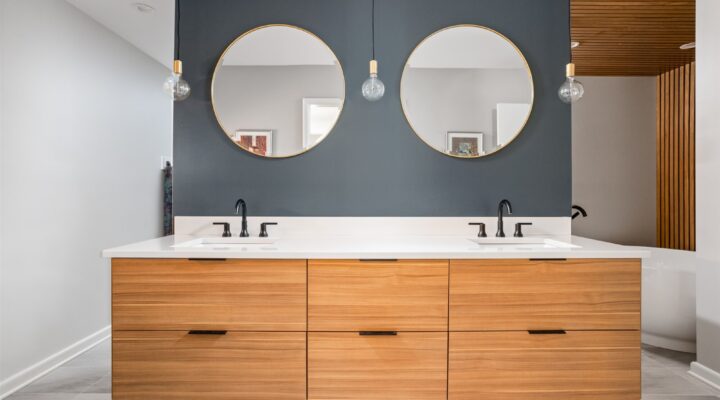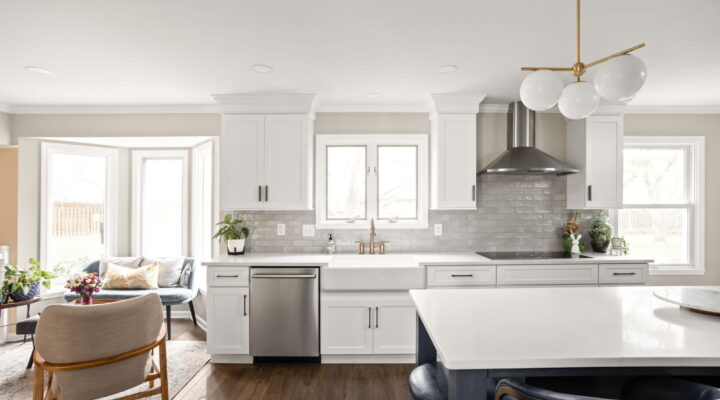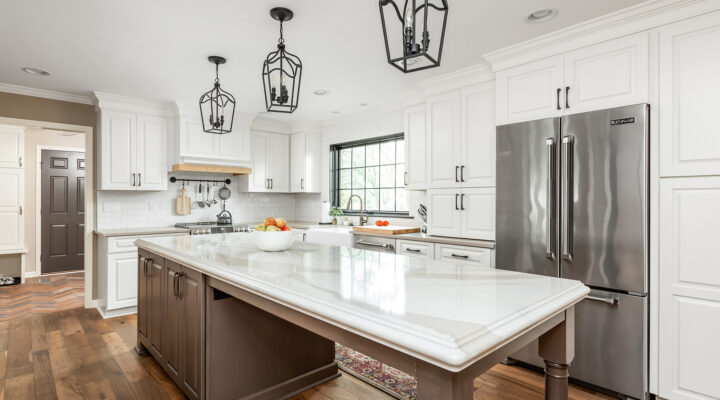A common trait of homes built in the Carmel neighborhood growth era of the 1990s is the kitchen design not reflecting the rest of the home. In many cases it seems like the builder treated the kitchen as an afterthought. The large open spaces, high-end materials and architectural detailing seen in the rest of the home was left out of the kitchen. Such was the case for the owners of this Foster Estates home. They felt it was time to finish what the builder had started.
 Goals: The homeowners had three goals for their kitchen remodel: 1) create a more spacious feel, 2) design an unique configuration and 3) bring the kitchen up to the look of the rest of the home. The original kitchen had many challenges: the bright white Thermofoil cabinets lent a cold feel, and the their placement down from the high ceilings made the space feel small; the peninsula trapped people in the kitchen and was too far from the cooking station to be of use for prep; the tile flooring was cold and showed every bit of dog hair and dirt; the lack of storage space meant cluttered countertops; and the pantry closet was not convenient to the active cooking space. The new kitchen design had address all of these issues, plus integrate the space into the rest of the home.
Goals: The homeowners had three goals for their kitchen remodel: 1) create a more spacious feel, 2) design an unique configuration and 3) bring the kitchen up to the look of the rest of the home. The original kitchen had many challenges: the bright white Thermofoil cabinets lent a cold feel, and the their placement down from the high ceilings made the space feel small; the peninsula trapped people in the kitchen and was too far from the cooking station to be of use for prep; the tile flooring was cold and showed every bit of dog hair and dirt; the lack of storage space meant cluttered countertops; and the pantry closet was not convenient to the active cooking space. The new kitchen design had address all of these issues, plus integrate the space into the rest of the home.
 Design Elements: The adjacent spaces around the original footprint played a large role in the final design of the new kitchen. The mudroom had three closets which created poor flow in the area. By reconfiguring the storage options, the design was able to incorporate some of the mudroom space into the kitchen, where it was more valuable. The design also called for infringing on the eating area beyond the peninsula. A new dining table was included in the plans to ensure comfortable clearances could be maintained in the expansion.
Design Elements: The adjacent spaces around the original footprint played a large role in the final design of the new kitchen. The mudroom had three closets which created poor flow in the area. By reconfiguring the storage options, the design was able to incorporate some of the mudroom space into the kitchen, where it was more valuable. The design also called for infringing on the eating area beyond the peninsula. A new dining table was included in the plans to ensure comfortable clearances could be maintained in the expansion.
 The new footprint allowed a wall of pantry cabinetry to be installed near the cooking triangle, offering increased storage and convenience. Removing the peninsula and pushing the perimeter cabinetry into the now smaller eating area made room for an island, increasing the flow and functionality of the kitchen.
The new footprint allowed a wall of pantry cabinetry to be installed near the cooking triangle, offering increased storage and convenience. Removing the peninsula and pushing the perimeter cabinetry into the now smaller eating area made room for an island, increasing the flow and functionality of the kitchen.
 New maple cabinets were installed with thick crown molding that matched the rest of the home. Raising the height of the cabinetry made the kitchen feel much more spacious and increased storage. The height of the ceiling required tall cabinetry, which them affected the cabinet door style. To keep its structural integrity, the homeowners had to choose a door style that included a middle rail. Matching decorative integrated panels were included on all exposed ends for a finished look from all angles.
New maple cabinets were installed with thick crown molding that matched the rest of the home. Raising the height of the cabinetry made the kitchen feel much more spacious and increased storage. The height of the ceiling required tall cabinetry, which them affected the cabinet door style. To keep its structural integrity, the homeowners had to choose a door style that included a middle rail. Matching decorative integrated panels were included on all exposed ends for a finished look from all angles.
 During the design phase, the homeowners played with the idea of installing espresso stained cabinetry throughout the kitchen to add a warm feel. However, through 3-D modeling software, they were able to see how that finish would darken the space. The soft white color they finally chose brought the warm feel the homeowners were looking for. They were able to bring the espresso color they liked also in through the island and the mudroom lockers.
During the design phase, the homeowners played with the idea of installing espresso stained cabinetry throughout the kitchen to add a warm feel. However, through 3-D modeling software, they were able to see how that finish would darken the space. The soft white color they finally chose brought the warm feel the homeowners were looking for. They were able to bring the espresso color they liked also in through the island and the mudroom lockers.
 Stone tile covered all of the exposed wall space behind the perimeter cabinetry, including behind the chimney-style range hood. The earthy tones of gold and rust brought the warmth the homeowners were looking for in the space. Black pearl granite countertops provide a balance for the white perimeter cabinetry, while the New Venetian granite compliments the island cabinetry. Scraped hickory wood flooring in a Candy Apple color was installed in the kitchen and the adjacent rooms offering a warm, cohesive look.
Stone tile covered all of the exposed wall space behind the perimeter cabinetry, including behind the chimney-style range hood. The earthy tones of gold and rust brought the warmth the homeowners were looking for in the space. Black pearl granite countertops provide a balance for the white perimeter cabinetry, while the New Venetian granite compliments the island cabinetry. Scraped hickory wood flooring in a Candy Apple color was installed in the kitchen and the adjacent rooms offering a warm, cohesive look.
 Spectacular lighting fixtures added architectural interest to the kitchen and eating area. The homeowner was attracted to the round shape as a contrast to the rectangles in the cabinets, island and dining table.
Spectacular lighting fixtures added architectural interest to the kitchen and eating area. The homeowner was attracted to the round shape as a contrast to the rectangles in the cabinets, island and dining table.
 Final Result: Reconfiguring the floorplan eliminated the typical u-shaped flow that was not working for these homeowners. Although space was stolen from adjacent areas, these spaces were redesigned to be even more efficient within their new footprint. Open space, better flow, warm colors and increased functionality came together to create a kitchen worthy of this beautiful home.
Final Result: Reconfiguring the floorplan eliminated the typical u-shaped flow that was not working for these homeowners. Although space was stolen from adjacent areas, these spaces were redesigned to be even more efficient within their new footprint. Open space, better flow, warm colors and increased functionality came together to create a kitchen worthy of this beautiful home.
